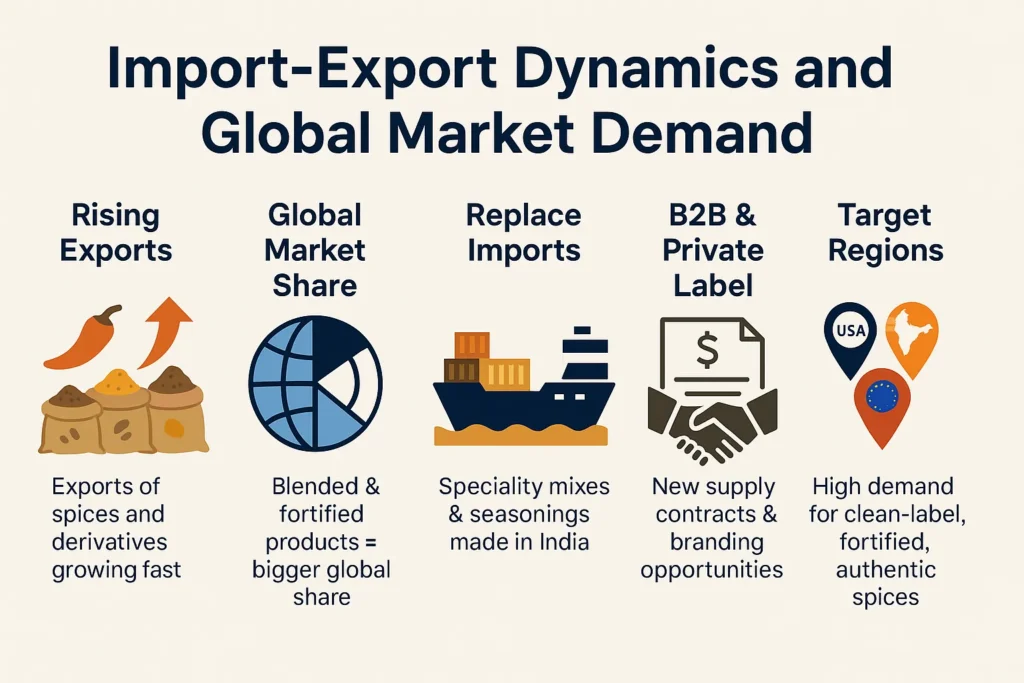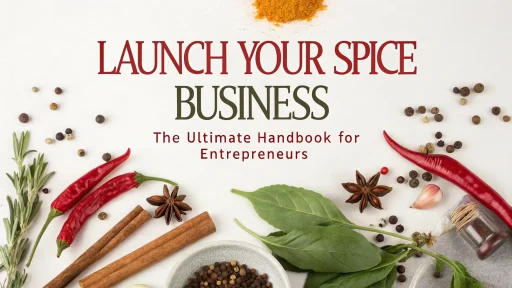India’s spice industry is now shifting from exporting bulk spices to high-value blends and fortified products. As indicated in the Spice Annual Report 2023-24, over ₹1.25 trillion worth of spices were exported and processed spices, and spice blends were the fastest-growing categories.
The changes in the industry allow spice blends and fortified seasoning businesses to thrive. These offer greater profit margins, stronger branding opportunities, and convenience and wellness trends.
This article examines the potential opportunities, the practical mechanisms of entry to the spice industry, and the support structures in place to help new businesses grow in this lucrative industry.
This article outlines the value chain framework, and provides benchmarks along with customized spacing designed for industry entrepreneurs.
Read More: Profitable Indian Kitchen Spice Business
Market Landscape: Growth of Blended and Fortified Spices
According to the Spice Annual 2023-2024, India is the leading producer and exporter of spices and spice blends. However, the industry still supplies whole spices, in spite of the increasing popularity of ready to cook spices, fortified spice blends, and other related products.
Blended and fortified spices enjoy high demand. Though there are cheaper versions available, blended and fortified spices are key to any meal preparation.
Multi-ingredient fortified spice blends are costly, but are key to the ready-to-eat meals. They are blended with culinary spices to supply the necessary spices for the fortified meal.
These blends are specifically designed for professionals. They are ready-to-eat, functional spices, and are compliant with many dietary restrictions.
Read Our Book: Click Here
The Benefits of Starting Up with a Focus on Fortified and Blended Spices
Adding value to spice products rather than bulk exporting them allow entrepreneurs to cash in on India’s agricultural dominance and simultaneous international consumer trends. Some of the benefits are:
- Profit margins are relatively higher than unprocessed spices.
- Possibilities of building a brand through packaging design, storytelling and product differentiation.
- Flavors with longer shelf lives and reduced logistics costs per unit.
- Availability of export ready products as global customers seek authentic and functional spice products.
- Opportunities in diet specific products (vegan, organic, low sodium, and fortified).
- The unique and versatile nature of blended and fortified spices, thus, provide a strong incentive for entrepreneurs to delve into the spice industry.
Most Promising Business Options
Ready-to-Cook Blends
Curry powders, seasoning sachets, and Biryani masalas are popular spice kits gaining traction in various parts of the world. The production process includes blending, sieving, sterilizing, and packaging while adhering to FSSAI, ISO, and HACCP quality systems.
Startups can partner with farmer cooperatives and purchase automated blending and packaging machines. The demand for Indian spices make it easier to export to the US, EU, and Middle East.
Health Fortified Seasonings
Herbal extracts, certain minerals, or vitamins blended with spice mixes are functional and on the rise. For instance, low sodium, potassium infused, salt or turmeric latte powder with fortified Vitamin D.
The Ministry of Food Processing Industries (along with MSMEs) focuses on innovation in food fortification technologies which makes this an extremely advantageous area for startups.
High-end and Premium Spice Mixes
Truffle masala, organic barbecue rubs, and exotic marinades are examples of luxury spice blends that are sold at very high prices in the international market. Startups may partner with premium brick-and-mortar stores in addition to high-end e-commerce sites, especially when paired with IndGAP and organic certifications.
Custom Spice Blends for the Food Industry and Foodservice
Sales to restaurants, quick service restaurant (QSR) chains, and food manufacturers as a B2B customer for spice blends is high margin and high volume. Startups can venture into business by offering private-label production for food brands across the globe, provided these brands follow rules of food safety, cost-efficiency, and consistency.

Import-Export Dynamics and Global Market Demand
According to the Spice Annual Report for the year 2023-24, exports of chilli, cumin, turmeric, and other value-added derivatives are growing at a strong pace. Further progression into blended and fortified products will enable India to
- Increase its share in the global market for processed food ingredients
- Replace imports of speciality mixes and functional seasonings
- Obtain B2B supply contracts and private-label opportunities
North America, Europe, and East Asia are regions that are actively looking to buy clean-label, fortified, and authentic spice products which provides lots of export opportunities for Indian startups.
Read Our Project Report: Click Here
Success for MSME and Models
In spice blending MSME sector has been taken to global level in regions of Kerala, Gujarat and Rajasthan. Many of these blenders have developed organic blend, diet friendly masalas, B2B spice blends and shifted to contracted blending for international brands.
Government resources for MSME (msme.gov.in), APEDA (apeda.gov.in), and MoFPI (mofpi.gov.in) will help global trade cost reduction.
Action Plan for New Spice Entrepreneurs
New spice entrepreneurs need to take a systematic approach that entails the following:
- Have NPCS conduct a feasibility study to evaluate and confirm product and market opportunities.
- Register for benefits under the PMKSY (MoFPI) and MSME technology schemes.
- Invest in modern blending, sterilization, and packaging machinery to meet global standards. For cost-effective and traceable purchasing, procure directly from Farmer Producer Organizations (FPOs).
- For international recognition, pursue FSSAI, HACCP, IndGAP, and Organic certifications.
- Create partnerships with e-commerce platforms, international distributors, and foodservice companies.
Find the Best Idea for Yourself With our Startup Selector Tool
How NPCS Assists Entrepreneurs
At Niir Project Consultancy Services (NPCS), we provide a full suite of consulting services to entrepreneurs, which entails extensive market surveys, techno-economic feasibility studies, and project reports.
Each of these contains critical elements such as market research, demand analysis, process flow diagrams, manufacturing processes, machinery requirements, raw material sourcing, capacity planning, and financial projections.
NPCS assists startups and MSMEs by evaluating the feasibility, profitability, and scalability of spice blending and fortified product businesses to aid in decision-making, securing financing, and marketing and expansion efforts.
Entrepreneurs in Spice Blends FAQs
Is selling spice blends profitable in India?
Selling blended and fortified spices is more profitable than exporting raw spices because there is more value-added, branding potential, and longer shelf life. Considering the growing export demand in India, startups in the sector expect to be very profitable.
What spice products should I start with for the best profitability?
Among the most popular products within the spice blending sector are ready-to-cook masala mixes (biryani masala, curry powders), fortified turmeric, and organic spice blends, as well as gourmet spice rubs.
How much money do I need to invest to start a spice blending unit?
To start a small scale spice blending and packaging unit, the estimated cost is between ₹20 to ₹30 lakhs. For more complex export oriented businesses with fully automated spice blending machines, the range is ₹1 to ₹2 crores with a starting investment. To ease the investment, the PMKSY subsidy and MSME schemes can help.
What are the licenses for a spice business in India?
To start, it is best to obtain the FSSAI for food safety. The GST registration, and an export license, too. For more certifications, you may try HACCP, ISO 22000, Organic, or IndGAP. These will help improve your credibility in the international market.
What are ways to find international buyers for spice blends?
Buyers for your exports can be found through APEDA trade promotion, international food fairs, as well as B2B websites like Alibaba and IndiaMART, and global distributor partnerships.







